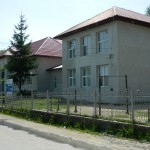What to visit in Tătărani
And this area is a delight for people places, but also for tourists who arrive in this region. Panoramas captured by cameras both winter and summer are particularly suggestive in this regard.






Churches
The churches in this area are from the nineteenth century and most have been renovated over the years with the help of residents in the commune and some private sponsors.
- Church of St. John the Baptist - Căprioru


Beheading of St. John the Baptist, St. Nicholas
Details: Built around 1805-1810 - Assumption Church, St. George - Gheboieni

Assumption, S, M. Mc. Gheorghe
Details: Built around 1820-1824 - Ascension Church - Priboiu


God Ascension
Details: Built around 1831-1835 - God Ascension Church - Tătărani


God Ascension
Details: Built around 1848
Back to top
Other sites
- The secular oak


Near the village there as a curiosity Gheboieni a "secular oak" which had about 500 years and was declared a natural monument. At this oak secular youth gather and celebrate important religious events as shade for luck in life. - Bottomless Lake
Also near the village Gheboieni there after a lake called Lake Bottomless about running an old legend: a procession of wedding guests passed this lake and drowned bride without the ever find. The lake actually turned into the swamp, has an oval shape and is very deep. - Legend fountain of eternal youth
Back Tatars in these places there is a very beautiful girl who fell to thump him captain. One day the prince fall in love with the girl he had seen at the entrance of an abandoned me. Although Tatar was told that she has a fiancé, he gave orders to be kidnapped girl. Fiance girl named Radu went to the Tartar prince and tried to resist causing the captain to fight.
This, however, put him killed.
Although it receives many wounds he dies.
Meanwhile fiance escapes from captivity and runs the mine. Tartar prince seeing that Radu is injured, but not dead man accepts the proposal, arguing that it can not defeat him.
RRadu the last power takes him defeat the Tartar after leaving the mine to find his girlfriend. A sadly found dead and knocking down a cliff leading to the collapse of the mine. Collapsed mine water from springs that are supposedly tears Radu. Hence the name of the spring. - Valley Ainoasei

An interesting point of Attraction is Ainoasei Valley (or Aninoasa) near the village Căprioru; The scenery is beautiful, the road through the woods and valleys full of greenery too.
OLD HOUSES



We draw attention to some very old houses by the current owners care still preserved and stand witness to the passing years and the exchange of generations over time. In front of a house near the church dedicated to the Ascension of Tătărani there is even a fountain that is supposed to be over 150 years. The high esteem and are particularly valuable monumental carved wooden doors of households, processed wood and fabric items popular in the area.
- Ion Badea house - Dealul Tătărani (sec. XIX)

- Wooden house magazine Adreana Pană (sec. XIX)

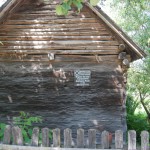
- Wooden house magazine Gostoroiu (sec. XIX)
- The house where he stopped Radu Anghel - Legend's Radu Anghel



Radu Anghel is actually the son of a pandur during Tudor Vladimirescu which in reality was a thief and a robber, but during the communist period was glorified as an outlaw. His life was full of adventures and illegalities committed in a fairly long period of time starting with the murder of a Turk who stole money from returning from a trip in Bulgaria and culminating with the murder of a priest in a monastery where hiding for fear of law enforcers who had come to arrest him for the atrocities committed. After he was wounded law enforcement officers trying to catch him, he fled to Campulung which will otherwise die due to injuries and. During his life bought with money from thieves at one time a tavern where weather puts troubadours who stopped at his pub to compose ballads that glorify him. These ballads years have passed and some of them have come to this day.
CROSSES AND CRUCIFIXES
Here again a few crosses and crucifixes missing the familiar meanings related to a series of events and people most important in past centuries. The crosses are made of stone technique called "Mepla" (stone is carved deep) and stone comes from quarries Albeşti (which proves that craftsmen were used instead of Albeşti).
- Stone Cross (house Gheorghe Săvulescu) - Gheboieni (sec. XVIII)
Built during Matei Basarab. - Stone Cross from "bolboci" - Gheboieni (1641)
- Stone Cross - Tătărani in front of elementary school (1738-1739)



- Old Crucifix - Dealul Tătăranilor
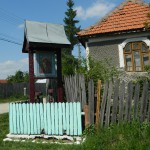
- New Crucifix - Dealul Tătăranilor

MONUMENTS
Besides these houses, churches, crosses and monuments Triptych there are some places that honor the heroes who died on the battlefield in both world wars.

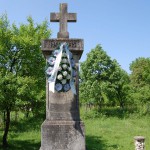

- Heroe's Monument - Căprioru
- Heroes Monument - Gheboieni
OTHER CONSTRUCTIONS
Back to top
Hiking trails
An interesting route should extend to the houses and monuments described above and Ainoasei valley where spring and summer months particularly colorful landscapes determines hard to describe in words.






Back to top
Customs and traditions
Tătărani village celebration is August 15th, occasion that occur every year cultural events in which both residents and numerous guests common. On this occasion you can see both traditional costumes of the region, and numerous craftsmen (specific activities such as pottery, traditional works in wood, etc).
In the area more than in other parts of Dâmboviţei kept apart common forms of religious holidays and some special forms specific to these places.
From the many celebrations and customs Dâmboviţa few preserved in archaic forms or slightly modified.
Day 1 March Mărţişorul after the old calendar was regarded as the beginning of a New Year feast of the coming spring.
The Martyrs, light fires to scare away snakes and people jumping over fires purifying purposes.
Feast of St. George came through strongly in the spirituality of Dambovita, whereas now be released heat of the earth. Villagers beat the earth with cudgel to rush release heat; stops for grazing meadow orchards and cattle are driven to the mountains.
Sânzienele - Roman holiday - starts at tight wheat (24 June). On this occasion, groups of girls were walking in cornfields being driven Drăgaica. The girls were picking ears of corn and flower fairies which wove a crown worn by this. Thrown over the house or hung from the eaves of the house sânziene crowns had magical powers of healing.
The St. Demetrius are Sumedru fires. Practice funeral ritual. And pre-Christian roots that are usually found in the celebration of death and rebirth, by incineration. The fire has purifying and regenerating role here. The ashes, coals and other debris from the pyre are taken by villagers to fertilize gardens and orchards.
Winter festivals to remember that St. Andrew is put wheat in a bowl, to estimate potential crop or richness year to come.
From Christmas carolers come to Saint John. The goat wander during this period, bear, Plugusorul, sorcova and New Year's night Vasilca go.
Rapsozi
Ballads, along with other genres of song elders, who have seen the maximum flourishing in the XVI-XIX, remain today in Dâmboviţa musical landscape
The prevailing thematic topics exploits (Miu Copiu, Corbea), outlaws (Radu lu Aghel), subjects with sensational character (Chira Chiralina, Joel Catania).
Rapsozii often accompanies his singing wind instruments (flute, kaval, bagpipes) on which they built themselves, unlike musicians who use string instruments (violin and dulcimer).
Traditional costumes
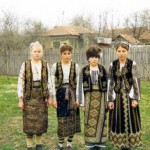 Costumul de Dambovita costume occupies an important place in the Romanian folk ensemble. Folk costume pieces were made in the house, all being well defined by its composition, respectively shirt altitute, ie with separate lap, cloth or veil, skirt, belt, sticks, knee-long, pinstripes, vest, waistcoat, socks, sandals and shoes.
Costumul de Dambovita costume occupies an important place in the Romanian folk ensemble. Folk costume pieces were made in the house, all being well defined by its composition, respectively shirt altitute, ie with separate lap, cloth or veil, skirt, belt, sticks, knee-long, pinstripes, vest, waistcoat, socks, sandals and shoes.
 Marama, decorative composition folk costume was thin fibers woven from cotton or silk. One of the representative areas of the port beauty is common Tătărani.
Marama, decorative composition folk costume was thin fibers woven from cotton or silk. One of the representative areas of the port beauty is common Tătărani.
 The costume is not worn only rarely: the elderly, special ceremonies, or younger at folk events. The most beautiful costume is usually kept in dowry, to be worn on the "path end".
The costume is not worn only rarely: the elderly, special ceremonies, or younger at folk events. The most beautiful costume is usually kept in dowry, to be worn on the "path end".
Sumedru's Fire - traditional celebration in the Căprioru
 Before the arrival of winter, residents are St. Demetrius "Fire Sumedru" celebration attended by village children but also adults. Children dressed in costumes specific place, make a fire and play sacred dances around him.
Before the arrival of winter, residents are St. Demetrius "Fire Sumedru" celebration attended by village children but also adults. Children dressed in costumes specific place, make a fire and play sacred dances around him.
The bravest take their momentum and fire jumping through fire or over Sumedru, protector of crops and shepherds. Fire in the hills is generally highest in the area and can be seen from great distances, providing a unique spectacle. Locals urge everyone by yelling, "Let the fire of Sumedru." Fire Sumedru is a holiday with a pronounced funeral. The roots of the pre-Christian and are usually found in the celebration of death and rebirth, by incineration. Today, pre-Christian elements are added to the Christian reading of Akatistos Saint Demetrios church and its very name Holy Martyr award deity slaughtered. Fire significance Sumedru is a scenario of death and rebirth of a deity phytomorphic annual, ceremonial comprising a violent death at the year old god by cutting a tree in the forest, followed by his rebirth by burning the night of 25 -26 October. The fire has purifying and regenerating role here. The ashes, coals and other debris from the pyre are taken by villagers to fertilize gardens and orchards.
Who skips fire will be healthy and marry that year. If plenty of quince and walnuts, winter will be hard. Also now the dead are remembered.
On 26 ocotmbrie, where New Moon will be short and mild winter.
If it is cloudy, wind or rain, snow will be large, cold and long winter. To check the weather, make Dulama between sheep herders. If it lies on a black sheep in the winter will be mild.
Ends sowing garlic tails are clipped horses that have beautiful hair. On October 27, the Pious Dimitrie the New Mission, take Poitra Sumedru when unravel Stan.
In the village Căprioru will do more shots for the holiday "Ainoasa deck to the village head and village in the north of the street near tarilu".
We are waiting for you to visit us!
In the area more than in other parts of Dâmboviţei kept apart common forms of religious holidays and some special forms specific to these places.
From the many celebrations and customs Dâmboviţa few preserved in archaic forms or slightly modified.
Day 1 March Mărţişorul after the old calendar was regarded as the beginning of a New Year feast of the coming spring.
The Martyrs, light fires to scare away snakes and people jumping over fires purifying purposes.
Feast of St. George came through strongly in the spirituality of Dambovita, whereas now be released heat of the earth. Villagers beat the earth with cudgel to rush release heat; stops for grazing meadow orchards and cattle are driven to the mountains.
Sânzienele - Roman holiday - starts at tight wheat (24 June). On this occasion, groups of girls were walking in cornfields being driven Drăgaica. The girls were picking ears of corn and flower fairies which wove a crown worn by this. Thrown over the house or hung from the eaves of the house sânziene crowns had magical powers of healing.
The St. Demetrius are Sumedru fires. Practice funeral ritual. And pre-Christian roots that are usually found in the celebration of death and rebirth, by incineration. The fire has purifying and regenerating role here. The ashes, coals and other debris from the pyre are taken by villagers to fertilize gardens and orchards.
Winter festivals to remember that St. Andrew is put wheat in a bowl, to estimate potential crop or richness year to come.
From Christmas carolers come to Saint John. The goat wander during this period, bear, Plugusorul, sorcova and New Year's night Vasilca go.
Rapsozi
Ballads, along with other genres of song elders, who have seen the maximum flourishing in the XVI-XIX, remain today in Dâmboviţa musical landscape
The prevailing thematic topics exploits (Miu Copiu, Corbea), outlaws (Radu lu Aghel), subjects with sensational character (Chira Chiralina, Joel Catania).
Rapsozii often accompanies his singing wind instruments (flute, kaval, bagpipes) on which they built themselves, unlike musicians who use string instruments (violin and dulcimer).
Traditional costumes
 Costumul de Dambovita costume occupies an important place in the Romanian folk ensemble. Folk costume pieces were made in the house, all being well defined by its composition, respectively shirt altitute, ie with separate lap, cloth or veil, skirt, belt, sticks, knee-long, pinstripes, vest, waistcoat, socks, sandals and shoes.
Costumul de Dambovita costume occupies an important place in the Romanian folk ensemble. Folk costume pieces were made in the house, all being well defined by its composition, respectively shirt altitute, ie with separate lap, cloth or veil, skirt, belt, sticks, knee-long, pinstripes, vest, waistcoat, socks, sandals and shoes. Marama, decorative composition folk costume was thin fibers woven from cotton or silk. One of the representative areas of the port beauty is common Tătărani.
Marama, decorative composition folk costume was thin fibers woven from cotton or silk. One of the representative areas of the port beauty is common Tătărani. The costume is not worn only rarely: the elderly, special ceremonies, or younger at folk events. The most beautiful costume is usually kept in dowry, to be worn on the "path end".
The costume is not worn only rarely: the elderly, special ceremonies, or younger at folk events. The most beautiful costume is usually kept in dowry, to be worn on the "path end".Sumedru's Fire - traditional celebration in the Căprioru
 Before the arrival of winter, residents are St. Demetrius "Fire Sumedru" celebration attended by village children but also adults. Children dressed in costumes specific place, make a fire and play sacred dances around him.
Before the arrival of winter, residents are St. Demetrius "Fire Sumedru" celebration attended by village children but also adults. Children dressed in costumes specific place, make a fire and play sacred dances around him.The bravest take their momentum and fire jumping through fire or over Sumedru, protector of crops and shepherds. Fire in the hills is generally highest in the area and can be seen from great distances, providing a unique spectacle. Locals urge everyone by yelling, "Let the fire of Sumedru." Fire Sumedru is a holiday with a pronounced funeral. The roots of the pre-Christian and are usually found in the celebration of death and rebirth, by incineration. Today, pre-Christian elements are added to the Christian reading of Akatistos Saint Demetrios church and its very name Holy Martyr award deity slaughtered. Fire significance Sumedru is a scenario of death and rebirth of a deity phytomorphic annual, ceremonial comprising a violent death at the year old god by cutting a tree in the forest, followed by his rebirth by burning the night of 25 -26 October. The fire has purifying and regenerating role here. The ashes, coals and other debris from the pyre are taken by villagers to fertilize gardens and orchards.
Who skips fire will be healthy and marry that year. If plenty of quince and walnuts, winter will be hard. Also now the dead are remembered.
On 26 ocotmbrie, where New Moon will be short and mild winter.
If it is cloudy, wind or rain, snow will be large, cold and long winter. To check the weather, make Dulama between sheep herders. If it lies on a black sheep in the winter will be mild.
Ends sowing garlic tails are clipped horses that have beautiful hair. On October 27, the Pious Dimitrie the New Mission, take Poitra Sumedru when unravel Stan.
In the village Căprioru will do more shots for the holiday "Ainoasa deck to the village head and village in the north of the street near tarilu".
We are waiting for you to visit us!
Search the site
Where to find us
The weather in Vulcana-Băi
Visitors

Local Tourist Information and Promotion Center Vulcana-Băi
Vlad Țepeș street, no. 11
Vulcana-Băi, Dâmbovița, 137535,
România
Vlad Țepeș street, no. 11
Vulcana-Băi, Dâmbovița, 137535,
România

© 2015 Infoturism-VulcanaBai.ro
 Română
Română English
English Deutsch
Deutsch





